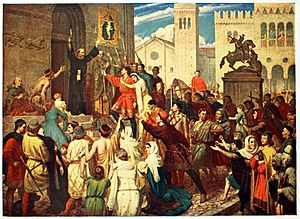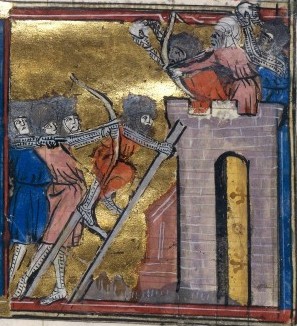Peter the Hermit facts for kids
Quick facts for kids Peter the Hermit |
|
|---|---|

Peter the Hermit preaching the Crusade to a crowd of people
|
|
| Religion | Roman Catholic |
| Church | Roman Catholic church |
| Other names | Cucupeter, Little Peter, Peter of Amiens, Peter of Achères |
| Personal | |
| Born | c. 1050 Amiens, France |
| Died | 8 July 1115 or 1131 |
Peter the Hermit (around 1050 – 8 July 1115 or 1131) was a Roman Catholic priest from Amiens, France. He became a very important person during the First Crusade. He helped lead a large group of ordinary people on a journey to Jerusalem. This journey was known as the People's Crusade.
Peter was also called Little Peter or Peter of Amiens. He was known for being a powerful speaker. Many people were inspired by his words to join the Crusade.
Contents
Peter's Early Life and Journey
Peter the Hermit was a priest. Before the First Crusade, he tried to make a pilgrimage, or religious journey, to Jerusalem. However, he was stopped by the Seljuk Turks. He was reportedly treated badly during this time.
This experience made him very upset. He began to speak strongly about the Turks. He wanted to encourage Christians to take action.
Peter saw upsetting things in Jerusalem. He visited the Church of the Holy Sepulchre. He saw that holy places were being disrespected. He also saw Christians being treated unfairly. They had to pay special fees. The local church leader told Peter that they were powerless against the strong rulers.
The Call for a Crusade
It's not clear if Peter was at the meeting where Pope Urban II first called for the Crusade. This meeting was the Council of Clermont in 1095. But it is certain that Peter became one of the main preachers of this armed pilgrimage in France. His own experiences helped him speak with great passion.
Peter quickly became famous. Many sources agree that thousands of ordinary people joined the Crusade because of his speeches. They were mostly farmers and peasants. This part of the First Crusade was called the Crusade of the Paupers.
Peter organized these people. He saw them as a holy group of pilgrims. He believed they would be protected by God. However, Peter did not train his army. He also did not provide them with weapons or food. Some historians think that some armed soldiers and nobles also joined Peter's group.
The Journey to the Holy Land
The leader of the Roman Catholic Church, Pope Urban II, asked Peter to lead this armed journey to Jerusalem. Peter also got permission from Patriarch Simeon II of Jerusalem. Peter was able to gather people from England, France, and other areas.
Peter the Hermit arrived in Cologne, Germany, on April 12, 1096.
Attacks on Jewish Communities
In the spring of 1096, Peter was one of the important Roman Catholic Church leaders. He was involved in the Rhineland massacres. These were attacks against Jewish civilians.
Peter and his followers took part in the killing of Jewish people. This happened in places like Lorraine, Cologne, Worms, Speyer, and Mainz. In Mainz, Peter's followers killed a large group of Jewish people. They had been given safety by a local bishop.
It is estimated that between 2,000 and 10,000 civilians were killed in these events. These killings are known as Gzerot Tatnó.
Through Hungary and the Balkans
Peter led the first group of the People's Crusade. They aimed to reach the Church of the Holy Sepulchre. He started from Cologne in April 1096 with about 40,000 people. They arrived in Constantinople by the end of July. By then, their numbers had dropped to about 30,000.
The Byzantine emperor Alexios I Komnenos was not happy to see them arrive. He and the head of the Eastern Orthodox Church, Patriarch Nicholas III of Constantinople, now had to feed and care for this huge group.
Before reaching Constantinople, Peter and his followers faced problems. In Zemun, a disagreement about shoes led to a riot. The town was attacked, and 4,000 Hungarians were killed. Many supplies were stolen.
On June 26, 1096, Peter's army crossed the Sava river. They then marched into Belgrade, set the town on fire, and robbed it. The army continued through Nish (Niš) after an eight-day delay. On the way to Sofia, they were attacked. The army lost a quarter of its men. But they still arrived in Sofia on July 12.
Arrival in Constantinople
The Crusaders arrived in Constantinople on August 1, 1096. Peter joined his group with another group led by Walter Sans Avoir. They camped around Constantinople. Peter tried to arrange for ships to take them to the Holy Land.
The Emperor Alexios was worried about the growing disorder. The hungry pilgrims started stealing from the imperial stores. So, the Emperor quickly sent them across the Bosporus to the Asian side. He warned them to wait for his orders. But the pilgrims entered Turkish territory anyway.
The Turks began fighting with the mostly unarmed group. Peter returned to Constantinople. He desperately sought the Emperor's help.
While Peter was away, the pilgrims were ambushed by the Turks. This happened at the Battle of Civetot. The Turks were more organized. Most of the pilgrims were killed or captured and enslaved. Peter stayed in Constantinople with the few survivors. They waited for the main Crusader armies to arrive. They hoped these armies would protect them to finish their pilgrimage.
Marching to Jerusalem
When the main Crusader leaders arrived in May 1097, Peter joined their council. He and his remaining followers marched with them through Asia Minor to Jerusalem. His group never got back to its original size. But it grew with Crusaders who had lost their weapons, were injured, or had run out of money.
Peter gave some inspiring speeches to motivate the Crusaders. But he played a smaller role in the rest of the First Crusade. This part of the Crusade was mainly a military campaign. Its goal was to secure the pilgrimage routes and holy sites in Palestine.
During the siege of Antioch in early 1098, Peter tried to escape. He was struggling with the lack of food. But he later gave a speech that motivated the Crusaders. This speech helped them win a surprising victory against the Muslim army. After this, Peter was sent to invite Kerbogha to settle their differences in a duel. Kerbogha declined.
In 1099, Peter helped manage the donations at the siege of Arqa. He also led religious processions around the walls of Jerusalem before it fell. Later, he led similar processions inside Jerusalem. These happened before the Crusaders' victory at the Battle of Ascalon in August.
At the end of 1099, Peter sailed back to the West from Latakia. After this, he mostly disappears from historical records.
Peter's Influence on the First Crusade
Some early historians, like Albert of Aix, claimed that Peter the Hermit was the true starter of the First Crusade. This idea was also found in later writings. It showed that even generations later, people believed Peter began the Crusade.
However, modern historians have shown this idea is not true. But it is known that Peter was a very influential preacher. He inspired many ordinary people to join the Crusade. Some legends say that Jesus appeared to Peter in the Church of the Holy Sepulchre. He supposedly told Peter to preach the Crusade. These stories show how much people admired Peter the Hermit.
Later Life and Legacy
There is not much clear information about Peter's life after he returned to Europe. Much of what is known is based on guesses or stories. However, Albert of Aix wrote that Peter died in 1131. He was the prior, or head, of a church of the Holy Sepulchre. Peter had founded this church in France or Flanders.
It is generally believed that he founded an Augustinian monastery named after the Church of the Holy Sepulchre. This monastery was in Neufmoustier, near Huy, in Flanders. His tomb is in Neufmoustier Abbey. This suggests that it was his abbey.
The chronicle of Neufmoustier Abbey mentions Peter's death. On July 8, 1115, it says that "Dom Pierre, of pious memory, venerable priest and hermit" died. It also states that he "deserved to be appointed by the Lord to announce the first to the holy Cross." The text continues, saying that "after the conquest of the holy land, Pierre returned to his native country." It also says he "founded this church ... and chooses them a decent burial." This record supports the idea that Neufmoustier was his foundation.

There is also a strong and old tradition that Peter the Hermit was the first to introduce the use of the Rosary. This tradition suggests he started it around 1090.
See also
In Spanish: Pedro de Amiens el Ermitaño para niños




